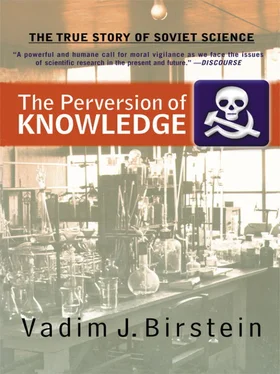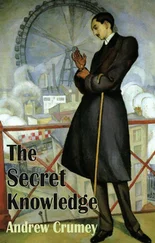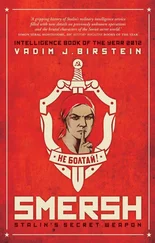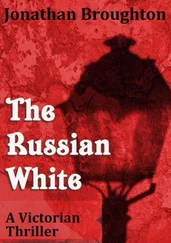Of these doctors, Boris Kogan (1896–1967) was a professor at the First Moscow Medical Institute and a consultant at the Barvikha Sanatorium of the Central Committee. Dr. Feldman (1880–1960) was a professor-otolaryngologist who headed a department at the Moscow Regional Scientific Research Clinical Institute. From 1936–1952, he was also a consultant at the Kremlin Medical Directorate. 268Professor-therapist P. Yegorov (1899–?) headed the Kremlin Medical Directorate. All those mentioned in this text, except Vinogradov and Yegorov, were Jews.
Ryumin’s team included even Stalin in the list of the supposed future victims of doctor-killers. During new interrogations, Vovsi and Kogan were forced to sign “testimonies” that in July 1952, they agreed to direct killings of Stalin, Beria, and Malenkov. 269As documents in the former KGB archives demonstrate, the handcuffed and beaten Dr. Vovsi, after the threats by Ryumin and his team that “[w]e’ll quarter you, hang you, impale you,” “confessed” that he received orders from the “bosses overseas,” that is, American Zionists. 270After the same treatment and Ryumin’s threat to torture him with two torches at the same time, Professor Yegorov admitted that he had “disabled” the secretary of the French Communist Party, Maurice Thorez, and had “killed” Georgi Dimitrov, the leader of the Bulgarian Communists, as well as Andrei Zhdanov and Aleksei Shcherbakov, and had damaged the health of many other Soviet and foreign Communist leaders. 271The minutes of all interrogations were sent directly to Stalin.
In January–February 1953, a new wave of arrests followed. On the whole, thirty-seven were arrested between the end of 1952 and the beginning of 1953 in connection with the Doctors’ Plot case. 272Of those, twenty-eight were doctors, and the others were members of their families. Natalia Rapoport, the daughter of Yakov Rapoport, one of the arrested doctors, recently recalled: “As I found out later, every night [my parents] were waiting for being arrested and visited their rare friends [who had not been arrested yet]. They gave them some money and warm clothes for me. In case of my mother’s arrest someone [of these friends] would send me to her to a labor camp…” 273
In early 1953, my family lived in a big apartment building in the downtown area of Moscow. Like most Soviet families, we had a room in a “communal apartment.” My grandmother and uncle lived in the next room. Five other families occupied the remaining five rooms of the apartment. At the end of 1952, my grandmother, who was a doctor and a Jew, lost her job. Many other high-ranking doctors lived in our huge apartment building. During that spring, almost each night somebody was arrested. Each night my parents waited for the MGB’s knock at our door. The MGB could arrest my father, a biologist and an anti-Lysenkoist, or my grandmother, a doctor. My parents discussed in whispers something that I could not understand at the time: what to do in case of possible deportation.
Many years later I found out the meaning of their night whispers. According to Stalin’s plan, after the Doctors’ trial and execution of the accused Kremlin doctors, all Jews would be deported from the cities to special labor camps. Stalin’s scenario consisted of five “acts.” 274First, sentencing doctors after their full confession. Second, execution by public hanging. Third, Jewish pogroms through the country. Fourth, an appeal by Jewish celebrities to Stalin asking for protection from pogroms and for permission to leave the big cities. Fifth, mass deportation of Jews “at their own request” to Siberian camps.
According to Nikita Khrushchev, the whole scenario was discussed at a meeting of the Central Committee Presidium (i.e., Politburo) in February 1953. 275Stalin’s resolution on the deportation of Soviet Jews to a special separate zone within the USSR was not passed. Stalin fainted and fell to the floor. This was the first indication of his serious health condition. He died two weeks after the meeting.
In the morning, at school, I heard the laughing of my classmates. One of them was a son of our building’s superintendent. According to the MGB rules, a superintendent had to attend the arrest of an inhabitant of his (or her) building. Our superintendent’s son told my classmates funny stories about the previous night’s arrests. Laughing, he used to say to me: “This night one more of your fellows was taken! My mom (the superintendent was a woman) said that it was so funny!” It was not clear if he meant one more Jew, a doctor, or simply an educated person. It was dangerous to belong to the intelligentsia at that time. I can still hear the laughter of my classmates when I recall those days.
Ryumin interrogated doctors personally and supervised their torture. Even his appearance was “horrifying… He was very short, and his small-sized, like children’s, galoshes stood in the same office. My heart dropped every time when he looked at me,” victim Ariadna Balashova later recalled. Additionally, Ryumin created a commission of three medical professors from the Kremlin Hospital (M. A. Sokolov, V. F. Chervakov, and S. A. Gilyarovsky) and deputy head of the MGB Central Clinic (N. N. Kupysheva) that conducted a special investigation of the medical treatment of Zhdanov and other alleged victims of “killer-doctors.” 276The pattern of Vinogradov, Shereshevsky and other doctors’ betrayal of Professor Pletnev in 1938, when they testified against Pletnev as official experts (see Chapter 2), was repeated. This time Vinogradov and Shereshevsky themselves were the object of the “investigation” by the MGB-selected commission of “experts.”
Despite all efforts, the efficiency of Ryumin’s investigation of doctors and the Jews who were former MGB officers was apparently low. Later Ryumin testified:
In September 1952 [MGB Minister] Ignatiev reproached me… that our information on the investigation cases looked very weak comparatively with that Abakumov had used to send to the Authorities [i.e., Stalin and the Politburo]… Ignatiev stressed many times that if we did not succeed in obtaining the necessary testimonies from the doctors-Jews, both of us would be dismissed and possibly arrested. 277
However, on November 14, 1952, only Ryumin was dismissed, and Ignatiev was placed personally in charge of the Doctors’ Plot case. After sophisticated torture techniques were applied, each one of the doctors confessed to all the fabrications suggested by their interrogators. One can clearly see Professor Pletnev’s model of 1938 (Chapter 2) in the Doctors’ Plot case. One of the arrested, Professor Vladimir Vasilenko, signed the following “testimony” on November 15, 1952:
The trial on Pletnev’s case… revealed for me the technique of killing patients by administrating incorrect treatments. From the materials of the case I understood… that the doctor could not only damage his patient’s health, but also lead the patient to death by cunning methods. I thought about this many times during the years that followed, remembering Pletnev, whom I personally knew. In July 1948, when I visited the ill Zhdanov [a member of the Politburo] at his bedside, I unwittingly remembered again Pletnev and his killings… And I decided to kill Zhdanov A. A. 278
In January 1953, a group of MGB operatives brought “Prisoner No. 12” Zhemchuzhina from Kazakhstan back to Lubyanka in Moscow. Through February 1953, she was interrogated every day in connection with the Doctors’ Plot. As Larissa Vasilieva, who had access to Zhemchuzhina’s investigation file at the KGB/FSB Archive, writes, “in her files are excerpts from the interrogations of Doctors Vinogradov, Kogan, Vovsi, who all confirmed that she was a Jewish nationalist.” 279The last document in the file dated March 23 is unique; it contains the following phrase: “It is now established that the statements by Kogan and Vovsi in the case against Zhemchuzhina were extorted through brutality and beatings.” 280On March 2, interrogations suddenly stopped: Stalin was dying. He died on March 5, 1953, and the nightmare of the Doctors’ Plot case was terminated.
Читать дальше











